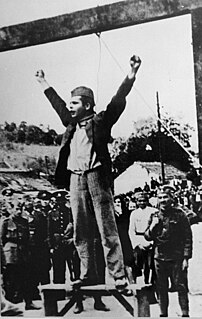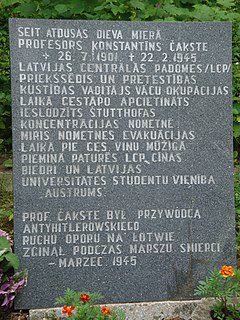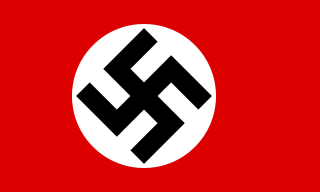 W
WAfter the occupation of Latvia by the USSR in June 1940, much of the previous Latvian army was disbanded and many of its soldiers and officers were arrested and imprisoned or executed. The following year Nazi Germany occupied Latvia during the offensive of Army Group North. The German Einsatzgruppen were aided by a group known as Arajs Kommando in the killing of Latvian Jews as part of the Holocaust. Latvian soldiers fought on both sides of the conflict against their will, and in 1943 180,000 Latvian men were drafted into the Latvian Legion of the Waffen-SS and other German auxiliary forces.
 W
WThe occupation of Latvia by Nazi Germany was completed on July 10, 1941 by Germany's armed forces. Latvia became a part of Nazi Germany's Reichskommissariat Ostland—the Province General of Latvia. Anyone not racially acceptable or who opposed the German occupation, as well as those who had cooperated with the Soviet Union, were killed or sent to concentration camps in accordance with the Nazi Generalplan Ost.
 W
WThe Guerrilla war in the Baltic states was an armed struggle waged by the Latvian, Lithuanian and Estonian partisans, called the Forest Brothers, against the Soviet Union during the Soviet invasion and occupation of the three Baltic states during and after World War II. Similar anti-Soviet Central and Eastern European resistance groups fought against Soviet and communist rule in Bulgaria, Poland, Romania, and western Ukraine.
 W
WMany Latvians resisted the occupation of Latvia by Nazi Germany. The Latvian resistance movement was divided between the pro-independence units under the Latvian Central Council and the pro-Soviet units under the Central Staff of the Partisan Movement in Moscow. Daugavpils was the scene of fierce Jewish resistance during the Holocaust. Many local Latvians were actively involved in the resistance movement against the ethnic policies of the German occupation regime. 134 Latvians were later honored with the title Righteous Among the Nations. Among them Žanis Lipke who risked his life to save more than 50 Jews.
 W
WThe Latvian Central Council was the pro-independence Latvian resistance movement during World War II from 1943 onwards. The LCC consisted of members from across the spectrum of former leading Latvian politicians and aimed to be the governing body of a democratic Republic of Latvia after the war. Its military units were an alternative to the Soviet partisans also operating in Latvia.
 W
WThe Molotov–Ribbentrop Pact was a non-aggression pact between Nazi Germany and the Soviet Union that enabled those two powers to partition Poland between them. The pact was signed in Moscow on 23 August 1939 by German Foreign Minister Joachim von Ribbentrop and Soviet Foreign Minister Vyacheslav Molotov and was officially known as the Treaty of Non-Aggression between Germany and the Union of Soviet Socialist Republics. Unofficially it has also been referred to as the Hitler–Stalin Pact, Nazi–Soviet Pact or Nazi–Soviet Alliance.
 W
WThe occupation of the Baltic states involved the military occupation of the three Baltic states—Estonia, Latvia and Lithuania—by the Soviet Union under the auspices of the 1939 Molotov–Ribbentrop Pact in June 1940. They were then annexed into the Soviet Union as constituent republics in August 1940, though most Western powers and nations never recognised their incorporation. On 22 June 1941, Nazi Germany attacked the Soviet Union and within weeks occupied the Baltic territories. In July 1941, the Third Reich incorporated the Baltic territory into its Reichskommissariat Ostland. As a result of the Red Army's Baltic Offensive of 1944, the Soviet Union recaptured most of the Baltic states and trapped the remaining German forces in the Courland pocket until their formal surrender in May 1945.
 W
WOperation Doppelkopf and the following Operation Cäsar were German counter-offensives on the Eastern Front in the late summer of 1944 in the aftermath of the major Soviet advance in Operation Bagration with the aim of restoring a coherent front between Army Group North and Army Group Centre. The operation's codename was a reference to the German card game Doppelkopf.
 W
WThe Reichskommissariat Ostland (RKO) was established by Nazi Germany in 1941 during World War II. It became the civilian occupation regime in the Baltic states and the western part of the Byelorussian Soviet Socialist Republic. German planning documents initially referred to an equivalent Reichskommissariat Baltenland. The political organization for this territory – after an initial period of military administration before its establishment – involved a German civilian administration, nominally under the authority of the Reich Ministry for the Occupied Eastern Territories led by Nazi ideologist Alfred Rosenberg, but actually controlled by the Nazi official Hinrich Lohse, its appointed Reichskommissar.
 W
WThe Soviet–Latvian Mutual Assistance Treaty was a bilateral treaty between the Soviet Union and Latvia, signed in Moscow on October 5, 1939. The treaty obliged both parties to respect each other's sovereignty and independence, while in practice allowed the Soviet government to establish military bases in Latvia, which facilitated the Soviet invasion of the country in June 1940.